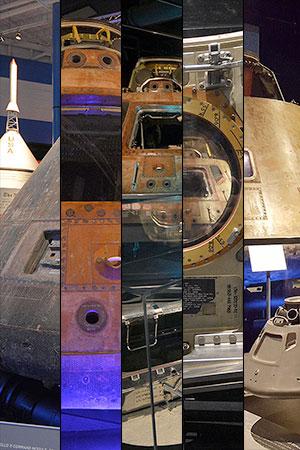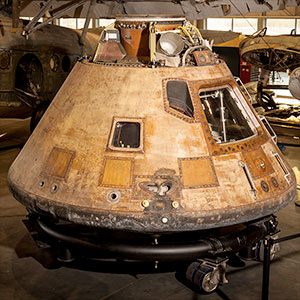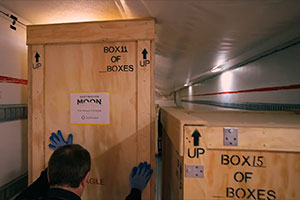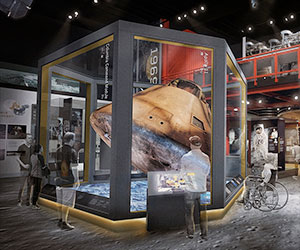February 18, 2020 — "Columbia" is once again bound for the District of Columbia.
The spacecraft, which half a century ago flew on the first mission to land humans on the moon, is returning to its home at the National Air and Space Museum in Washington, DC after completing a two-year, five-city tour as the centerpiece of the Smithsonian's "Destination Moon: The Apollo 11 Mission" traveling exhibition.
But first, Columbia has one more destination to visit.
"After two years touring the nation as part of a traveling exhibition, the Apollo 11 command module Columbia will return home this March," the National Air and Space Museum announced on its website. "The spacecraft will be on view at the Steven F. Udvar-Hazy Center in Chantilly, Virginia, for approximately one year until it is taken off display to be prepared for installation in the upcoming 'Destination Moon' exhibition at the museum in DC."
The gumdrop-shape spacecraft and the more than 20 related artifacts that accompanied it on the "Destination Moon: The Apollo 11 Mission" tour finished its fifth and final run on Monday (Feb. 17) at the Cincinnati Museum Center in Ohio. Organized by the Smithsonian Institution Traveling Exhibition Service (SITES), "Destination Moon" allowed the capsule to remain on public display through the 50th anniversary of its mission while the Air and Space Museum's building on the National Mall underwent a multi-year, still-ongoing renovation.
"The end of the 'Destination Moon' tour is bittersweet," said Kathrin Halpern, SITES project director, in a statement provided to collectSPACE. "We began with the concept of looking back to celebrate the 50th anniversary of the moon landing, but also looking forward to the future. We wanted to frame the historical context, share engaging stories and highlight the tremendous efforts of hundreds of thousands of people around the country who came together to achieve this monumental goal."
"We hope we have inspired visitors to dream and strive for their own moonshots, whatever they may be," Halpern said. "It has been an honor to work on this exhibition with so many talented and passionate individuals — a cast of hundreds — all around the country."
From centerpiece to showcase
Beginning on March 3, Columbia will be on view just outside the entrance to the James S. McDonnell Space Hangar at the Steven F. Udvar-Hazy Center. The capsule, which carried astronauts Neil Armstrong, Buzz Aldrin and Michael Collins to the moon and back, will temporarily take the place of a Loon missile located behind the display of a Lockheed SR-71A "Blackbird" reconnaissance aircraft.
The command module will be displayed in the same configuration as it appeared at the center of the "Destination Moon" traveling exhibition, sitting atop a modified transport ring with a fence, rather than a case, protecting it from public contact. This will be the last opportunity to see the capsule out in the open.
"We will have the Columbia in a new case," said Michael Neufeld, a curator at the National Air and Space Museum, describing the spacecraft's future exhibit in the "Destination Moon" gallery opening in early 2022. "It will not be on its ring. It will be in a new case, which will enclose it entirely, but it will be tilted up such that the hatch end is tilted down so that you can see into the cockpit."
"One of the things we couldn't do on the tour was illuminate the cockpit or really allow any view of it," Neufeld said. "But now there will be more ability to see into the cockpit."
Many of the artifacts that toured with Columbia, including a recovered injector plate from one of the Saturn V rocket engines that launched the Apollo 11 mission and one of the two storage boxes that was used to return the first moon rocks to Earth, will also go on display in the "Destination Moon" hall. They will be held at the Udvar-Hazy Center, but off of public view, until the new exhibition is ready.
The new "Destination Moon" exhibition will also include many more artifacts that were not part of the tour, including Alan Shepard's Mercury capsule and spacesuit, the Gemini 7 spacecraft and Armstrong's fully-conserved Apollo 11 spacesuit.
Tracking Columbia
The "Destination Moon: The Apollo 11 Mission" traveling exhibition began on Oct. 14, 2017 at Space Center Houston, the official visitor center for NASA's Johnson Space Center in Texas.
From there, Columbia and its associated artifacts visited the Saint Louis Science Center in Missouri from April through September 2018 and then was on display at the Senator John Heinz History Center in Pittsburgh, Pennsylvania through February 2019. In April 2019, the exhibition opened at The Museum of Flight in Seattle, Washington, where it was on view for the 50th anniversary of the Apollo 11 mission three months later.
The tour was originally planned to end there in Seattle, but due to changes to the National Air and Space Museum's renovation schedule, a fifth venue was added — Union Terminal at the Cincinnati Museum Center.
In total, the "Destination Moon: The Apollo 11 Mission" exhibition was viewed by nearly three-quarters of a million people. In the course of reaching those audiences, the artifacts traveled approximately 10,000 miles (16,000 kilometers) while crossing the nation. It was only the second time that Columbia had toured the country, after NASA's 26,000-mile (42,000-km) 50 U.S. state tour in 1970 and 1971. (By comparison, Columbia traveled 953,054 miles [1,533,792 km] on its 1969 voyage to the moon and back.)
FedEx provided the transportation for the Smithsonian tour, moving 58 custom crates on two 53-foot (16-meter) tractor-trailer trucks. The Smithsonian fabricated a custom transport crate for Columbia that supported a stable temperature and relative humidity environment, mitigated transit vibration and shifting, and facilitated rigging into and out of the host museum building. The FedEx transports were also temperature controlled and had air ride suspension systems. |
|

Slices of the Apollo 11 command module Columbia as it was seen on display at each of the five venues that hosted the Smithsonian's "Destination Moon: The Apollo 11 Mission" traveling exhibition from October 2017 through February 2020. (collectSPACE)

The Apollo 11 command module Columbia, seen at the Steven F. Udvar-Hazy Center in 2016, is returning to the National Air and Space Museum's Virginia annex for a year-long display beginning on March 3, 2020. (Smithsonian)

A FedEx employee loads onto a truck one of the 58 crates holding artifacts that were part of the Smithsonian's "Destination Moon: The Apollo 11 Mission" traveling exhibition. (FedEx)

Artistic rendering of the Apollo 11 command module Columbia as it will be displayed in the National Air and Space Museum's new "Destination Moon" exhibition opening in early 2022. (Smithsonian) |
